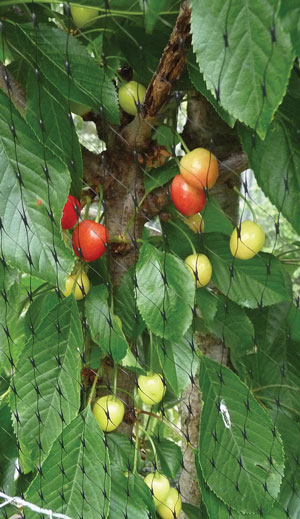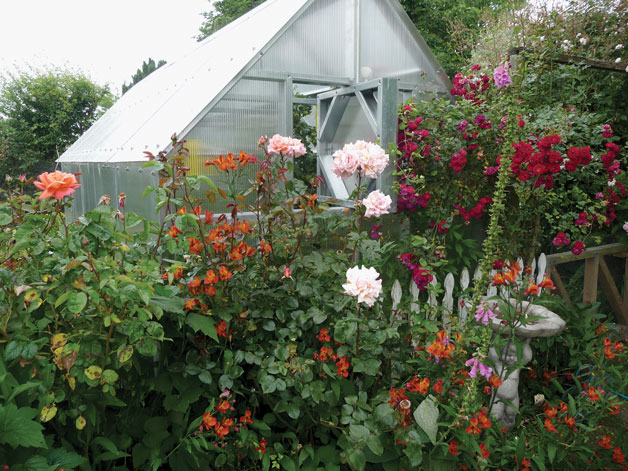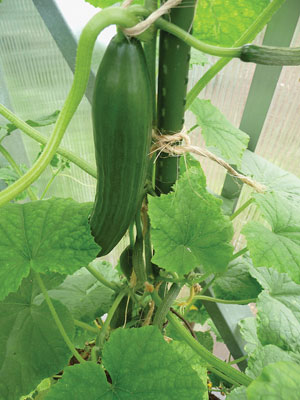Hei Mahi MāraMāhi Māra Wairua
Dec 5, 2012

A beginner’s guide to growing organic vegetables
Nā Tremane Barr
I recommend that people who have large home gardens have soil tests every three to five years, or when one is first starting out in establishing a sizeable māra.
Photographs Tremane Barr

Cherries
The tastes of summer from my māra are a welcome surprise as the limited diet I am on due to a recent diagnosis of pancreatic cancer (the chook food diet I call it – mainly vegetables, seeds, nuts and fruits appropriate to my blood type) has invigorated my taste buds.
This new emphasis on my māra as a key component in my recovery from cancer has in turn led to a reorganisation of priorities in terms of plants that I grow, as I have a limited range of vegetables that are useful to my health right now. The key vegetables are silver beet, broccoli, kale, spinach, chicory, leeks and carrots; which I need in bulk due to the green juices and raw food salads I eat every day. These plant varieties contain the types of minerals, vitamins and antioxidants which recent research has shown are beneficial in promoting recovery from cancer. No sweetcorn, pumpkin, onions or rīwai this season. However, I have made space for lettuces, peas, cucumbers, capsicums, and acid-free and heirloom tomatoes for a bit of variety.
Since I am relying so much on the māra for my health, I decided for the first time that it would be a good idea to test the soil to find out what the nutrient levels actually are. Overall, the soil test showed a pH of 6.6, which is on the high side, so no need for lime for a few seasons. Nitrogen, potassium, calcium, magnesium, boron and organic matter content are slightly above average. The selenium and copper levels are on the low side, but the phosphorous level was literally off the chart. Initially I was bit concerned by this phosphorous result, but soil scientist Dr. Tim Jenkins pointed out that this is not unusual for home gardens, and that due to the organic matter levels in the soil this should buffer the nutrients that become available to the plants. I am having some leaf samples tested for nutrient levels just to be on the safe side.

Roses in tunnel house
Because of the soil test results I decided to change my compost type from an organic chicken manure high in nitrogen and phosphorous to a commercial organic compost that is more balanced. The results were a wakeup call for me to be more precise about what I am actually putting into my soil. My presumption that more compost can only be better is not necessarily true. I recommend that people who have large home gardens have soil tests every three to five years, or when one is first starting out in establishing a sizeable māra. These test results also confirmed the need for me to use biodynamic preparations. I hadn’t used any since the 2009–10 season due to the earthquakes, but they were necessary to help enliven the soil and balance out the nutrient uptake by the plants. And hopefully we are past liquefaction-producing quakes.
The nutritional content of vegetables and soil health have also been key concerns of mine over the past few months, and after some research it brought back to me the need to focus on increasing the mineral content in my soil to be taken up by the plants. This is important because it is not enough just to have the right amount of vitamins in one’s daily diet, particularly when trying to recover from a serious illness. The right amount of minerals and trace minerals is particularly important, as the vitamins cannot do their work properly without them.
Recent research shows that agricultural soils in the United States have been depleted of 85% of their minerals in the past 100 years. In Africa the figure is 74%, Asia 76%, Europe 72%, South America 76% and Canada, 85%. This in turns shows up in dramatic declines in the mineral content of food crops, with a subsequent negative impact on overall population health statistics. There are two main culprits: petroleum-based NPK fertilisers stripping soils of their organic matter and mineral content, and new varieties of high yielding crops (in gross weight) deficient in wider nutritional factors such as minerals.

Cucumbers in tunnel house.
I haven’t been able to track any data on historical mineral depletion in New Zealand soils, but I think it can be safely assumed that a similar mineral loss profile has occurred here. What we do know is that there are natural deficiencies such as low levels of selenium which can require long-term supplementation in the soil or, in my case, eating two Brazil nuts a day.
The solution to the first issue is to switch to an organic approach, but even then research shows, on average, a marginal increase in nutritional value in most organic foods. The key is to directly supply the necessary trace minerals to the soil. I have used the Agrissentials rock mineral fertilisers this season, though I will be looking to supplement the selenium levels further. Liquid fertilisers like those based on seaweed can also be helpful for trace minerals.
I don’t want to leave you with the impression that I think that cancer can be cured through the use of diet alone. I believe a healthy diet tailored to the needs of the individual is an important step forward in creating the physical foundation for recovery. The magic of any health miracle, I believe, is found in being fearlessly true to oneself, and from there choosing a path to a positive life and treatment methods (conventional and/or holistic).
Anita Moorjani learnt this lesson the hard way. I recommend that everyone checks out the story of her inspirational near-death-experience, because ultimately it is how we tend the garden of our wairua (soul) that makes the real difference in life.
Recommended links: